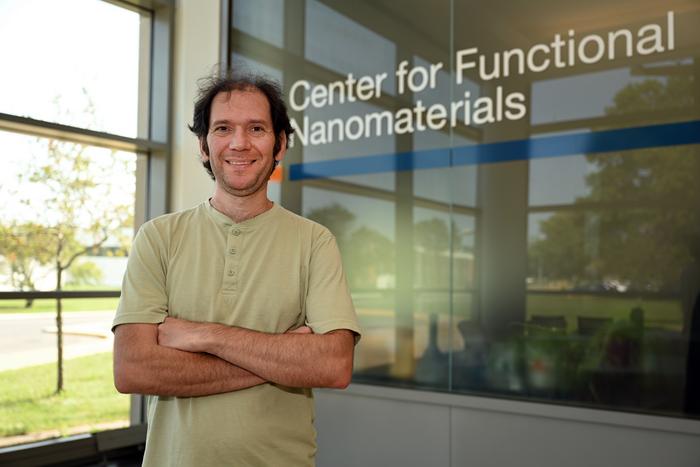Anibal Boscoboinik, a materials scientist at the U.S. Department of Energy’s (DOE) Brookhaven National Laboratory, has been named an “Inventor of the Year” by Battelle Memorial Institute. Battelle, headquartered in Columbus, Ohio, partners with Stony Brook University to form Brookhaven Science Associates, which manages the Lab on behalf of DOE’s Office of Science. Battelle manages or co-manages nine national labs across the country.

Credit: (Kevin Coughlin/Brookhaven National Laboratory)
Anibal Boscoboinik, a materials scientist at the U.S. Department of Energy’s (DOE) Brookhaven National Laboratory, has been named an “Inventor of the Year” by Battelle Memorial Institute. Battelle, headquartered in Columbus, Ohio, partners with Stony Brook University to form Brookhaven Science Associates, which manages the Lab on behalf of DOE’s Office of Science. Battelle manages or co-manages nine national labs across the country.
At Battelle’s yearly Celebration of Solvers, they award Inventor of the Year to an individual from each institution under Battelle management. The ceremony honors contributions to science or engineering that hold promise to positively impact society.
“I am very happy to represent Brookhaven National Lab with this award and thankful to all the people who contribute to the work that we do here,” Boscoboinik said. “There are lots of people participating, from the students and postdocs doing the research to the technical and administrative staff.”
Boscoboinik received the title this year for his role in developing materials that can trap and separate noble gases such as radon, xenon, krypton, and argon. It’s a tough task because these gases are inert, or unreactive.
Noble gases are typically separated out from gaseous mixtures by a process called cryogenic distillation, which requires condensing the noble gases at their respective freezing points. These points are very low across the board. However, many industries would benefit from capturing these substances at higher temperatures.
To work toward this goal, Boscoboinik studies 2D porous materials he calls nanocages at the Center for Functional Nanomaterials (CFN) and the National Synchrotron Light Source II, both DOE Office of Science user facilities at Brookhaven. These nanocages are much, much thinner than even a single sheet of paper — it would take 200,000 nanocages on top of one other to reach the thickness of a sheet of paper.
Boscoboinik stumbled upon the nanocages’ ability to contain noble gases above their frigid freezing points by fortuitous coincidence.
“We were trying to study the chemistry of a surface when we saw that it trapped noble gases. It was a complete accident. We were curious about it, so we published it, and then we started learning about the many applications that can result from trapping these gases,” he recalled.
During the 2020 National Lab Accelerator Pitch Event held by the Innovation and Partnerships Office at DOE’s Lawrence Livermore National Laboratory, Boscoboinik said, “You may wonder, ‘Why do we care about trapping noble gases?’ The truth is there are a variety of applications ranging from preventing lung cancer to industrial production.”
The first of these two addresses radon inhalation, which causes lung cancer and is responsible for tens of thousands of deaths annually in the U.S. alone. The Battelle award honors how Boscoboinik and his team’s radon-trapping nanocage technology could provide an affordable and effective method of removing radon from buildings.
“If we can get this material to trap the radon so people don’t breathe it in, that would be something extremely useful,” he summarized. “So, we’re thinking of ways to incorporate this technology into something like an air purifier.”
The second idea relates to facilitating the energy-efficient production of xenon and krypton, which could improve the efficiency of industries that produce lighting, anesthetics, electronics, and satellites.
Overall, the markets for Boscoboinik and his team’s award-winning technologies are worth hundreds of millions of dollars and could save many lives. To that end, Boscoboinik noted in a 2021 interview, “Nanoscience is fascinating. It can, and it will, change the world.”
Boscoboinik has a licentiate degree in chemistry from the Universidad Nacional de San Luis in Argentina. He earned his Ph.D. in chemistry in 2010 at the University of Wisconsin-Milwaukee. After a few years at the Fritz-Haber Institute of the Max-Planck Society in Berlin, Germany, he came to Brookhaven’s CFN in 2013. He previously won the Brookhaven Science and Technology Award in 2022 and the Alexander von Humboldt Fellowship in 2011.
Brookhaven National Laboratory is supported by the Office of Science of the U.S. Department of Energy. The Office of Science is the single largest supporter of basic research in the physical sciences in the United States and is working to address some of the most pressing challenges of our time. For more information, visit science.energy.gov.
Follow @BrookhavenLab on social media. Find us on Instagram, LinkedIn, X, and Facebook.



